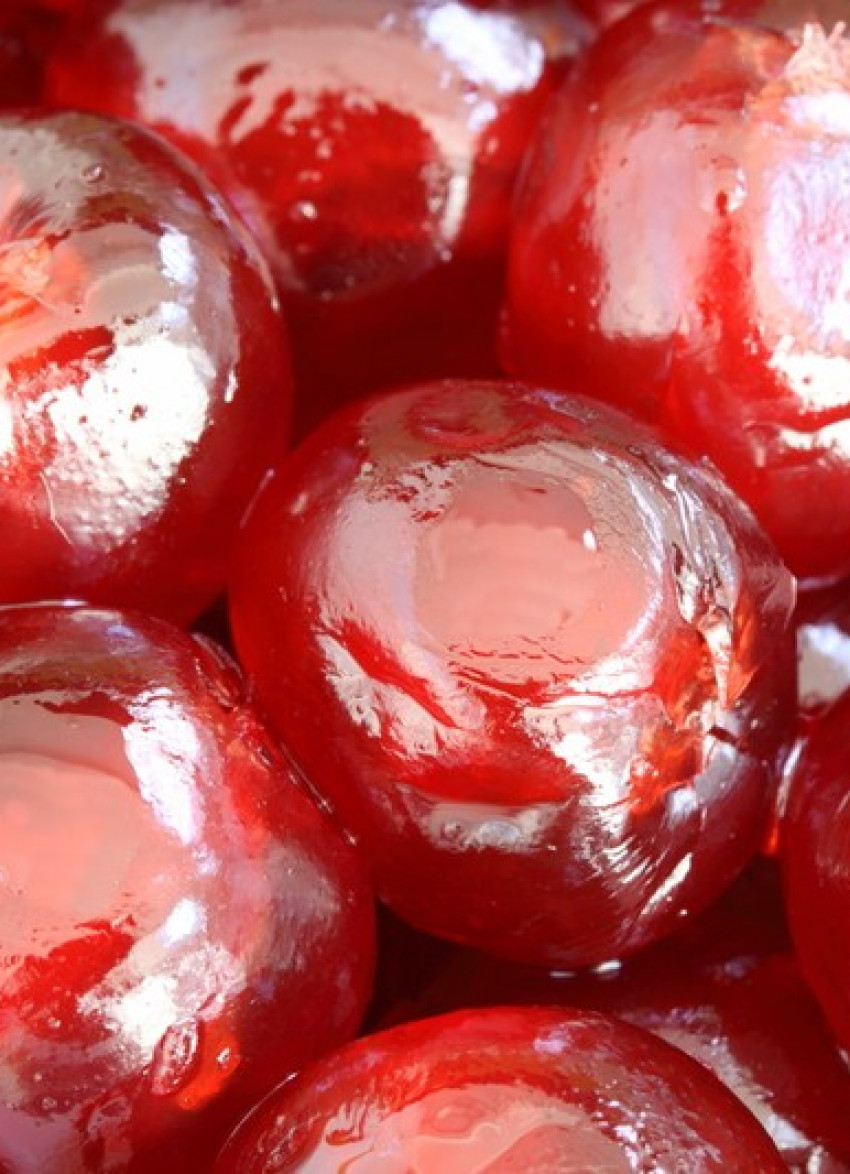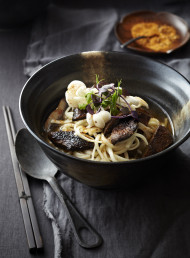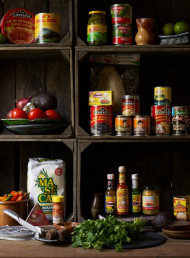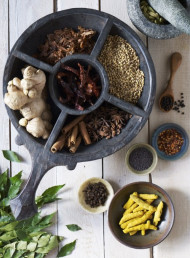A guide to: dried and glace fruits

Highly prized for centuries and a fundamental part of festive food – Sarah La Touche looks into the sticky and sweet world of dried and glacé fruits.
When Christmas comes along – even in our warm, sub-tropical summer – it would be hard to imagine this festive, family time without our fair share of dark, rich fruitcake, Christmas mince tarts, candied fruits and nuts. For many of us our culinary yuletide traditions have been with us since childhood, as many families pass Christmas food rituals on from generation to generation. Not surprisingly these traditions are echoed throughout the world, and with many differing cultures, shaped to a large degree by religious beliefs and festivals.
In 17th century England, a ‘Bill of Fare’ for Christmas Day lunch included preserved fruits to be served between the Standing Tart in Puff-Paste and the Six Dried Neat’s Tongues. In colonial America a Christmas brunch menu from 1769 mentions Mincemeat Pie, Plum Pudding and walnuts. Things haven’t changed too much – except perhaps for the dried neat’s tongues – believed to be the tongue of an ox or calf.
In Germany they eat Stollen, a yeasted bread made with ‘succade’ (candied citrus peel), almonds, cardamom and cinnamon. In Italy it is panettone – a large, domed loaf. Traditionally eaten at Christmas and Easter, this festive bread is a light, sweet brioche scattered with crystallized and dried fruits and topped with candied sugar. In the region of Milan, a quarter of the cake would be hidden away till early February when it would be eaten to ward off winter colds. Another Italian festive cake, the dense, sensuous panforte from Siena is made with the fragrant spices of cinnamon, nutmeg, coriander, cloves and peppercorns, and studded with crystallized fruits and toasted nuts including almonds, hazelnuts and walnuts.
Here in New Zealand, it just wouldn’t be Christmas without the odd mince tart or two. Inherited from our English ancestors, favourite recipes abound for the dense, dark, intensely sweet mincemeat encased in light, buttery shortcrust pastry. Originally, these tarts were made with real minced meat, spices, honey, dried and crystallized fruits. At some point in culinary history the meat was omitted but the dried fruits remained. The basis of good “mince meat” is dried Corinth currants (considered to be of the highest quality) and raisins with candied peel. Clove, mace and nutmeg are the staple spices and some add a little brandy and chopped almonds – but shredded suet is a must for an authentic mince tart.
Although obviously not English, the towns of Pézenas and Béziers in Southern France are two places that continue to make sweet mince tarts with meat. Called Petit Pâté de Pézenas (or Béziers as the case may be), and considered a great delicacy, they are made with ground mutton, dried fruits and spices, lemon zest and suet pastry. The recipe was brought to the region by Lord Clive, Viceroy and Governor of India, who settled there in the 17th century.
Why is it that dried and glacé fruits, walnuts, brazils, pecans, almonds and hazelnuts are all so synonymous with Christmas? Fruitcake, one of the most popular forms in which we eat dried fruits, nuts and candied fruits, can be traced back to the Holy Lands and some say its rich and abundant ingredients represent the gifts of the Three Wise Men.
We can be fairly certain that dried and candied fruits have their roots firmly planted throughout these lands, and that it was the Crusaders who actually brought these delicacies to the European world. But they were highly perishable foods so had to be preserved in some form. It was soon discovered that the hot sun and dry climate were perfect tools to drive off the moisture in fruits, dehydrating them and therefore making them last longer. While the dried fruits wouldn’t last forever, they were certainly stable enough to transport over the long journey back to Europe where they were regarded as treasured gifts.
Other influencing factors like climate, especially in Northern European and Scandinavian countries, and the seasonal nature of fruits and nuts, meant they could not be consumed throughout the year unless they were dried or preserved in some form. Over time, preserving methods like air-drying nuts so they could be stored for consumption outside their harvest times, slowly increased their availability.
In countries like France and Italy and in parts of the Middle East some fruits are still sun-dried. But increasingly large hot-air dehydrating machines are used to dry the fruits, as is the case with the Pruneaux d’Agen from France, or those delicious Californian prunes, currants and raisins so readily available to us now.
In medieval times these exotic ingredients were highly prized because of their scarcity, and when given they were an extraordinary treat. Certainly never seen during winter months, they were used sparingly: scattered through breads and cakes and served at banquets and on special occasions. Prior to the Crusades, fruits were preserved mostly with honey. With the introduction of sugar, still a rare and expensive commodity then, techniques improved and the crystallized or candied fruits we enjoy today began to evolve. Their fame spread and they were given as gifts to Popes and royalty.
In Provence, currently recognised as one of the world capitals of glacé fruit production, glacé fruits and fruit pastes are still commonly given as gifts. Packaged in a dazzling array of elaborate boxes and tins they are always included – along with dried nuts such as hazelnuts, brazils, almonds and nougat – in the time-honoured 13 Desserts of Christmas, which symbolize Christ and his apostles. Although not quite so fashionable here as in Europe and Middle Eastern countries, these delicious treats are making a comeback, especially for our traditional festivals like Christmas and Easter.
Crystallized fruit answers to various names: candied, glacé or glazed fruits are finished in sugar syrup, while crystallized or frosted fruits are coated in sugar afterwards. Fundamentally, they all refer to fruit which has been picked just ripe, washed and dried carefully before being coated or steeped in sugar or sugar syrup to varying degrees.
The method of candying fruit is long and arduous and recipes vary. The best is made lovingly and laboriously by hand, which explains why it is quite expensive, although a large proportion of the production has been mechanised in recent years. The many types of fruits are treated differently, depending on their shape and size. Some are peeled, as in the case of small pears or apples, others are cut into pieces, or just the peel is used, as with most citrus. Stone fruits like apricots, peaches and plums can be pitted, and some are left entirely whole, even with the stem remaining. Not all fruits are suited to this – the higher the water content in the fruit, as with strawberries for example, the less ideal they are for preserving this way.
Fruitcake, one of the most popular forms in which we eat dried fruits, nuts and candied fruits,can be traced back to the Holy Lands…
The surface of the fruit is pricked with metal needles to allow the sugar syrup to penetrate to the centre of the fruit, and for the water in the fruit to exit. If any water is left and not replaced by the sugar syrup the fruit will spoil. The fruit is blanched or sometimes cooked gently for a short time. Next, it is placed in cauldrons filled with sugar syrup and brought to the boil. It is cooled, several times and re-dipped in the sugar baths over a period of three to four weeks, sometimes several months, and in some cases for up to a year. The strength of sugar syrup is increased over time allowing the syrup to fully saturate all the cells of the fruit. The fruit is then left in syrup for several months to steep. Lastly, it is dipped in a solution of pure, concentrated sugar, and dried which helps to provide a protective coating and reduces stickiness. This is the case with true glacé fruits but with lesser quality glacé fruits this later step is eliminated. The glacé cherries we buy in the supermarket for baking are a good example of this.
Some fruits are finished with a fine sugar coating to create a frosting on the outside. Crystallized ginger, a special Christmas treat, or crystallized orange peel are made this way. The fruit can then be packaged and as long as it is stored in a cool, dry place will keep for years. Humidity however, is crystallised fruit’s number one enemy. While still quite usable for cooking, even the smallest amount of moisture will reduce it to a sticky mess.
The most common fruits we see candied are the citrus family, and most commonly their peel, also known as ‘succade’. This name also refers to the candied citron or citrus medica. One of the largest members of the citrus family, its extra-thick, jewel-like green skin has a milder, less bitter taste than its other citrus cousins. It makes a pretty addition to any cake calling for crystallized or glacé fruit.
Candied peel is most commonly used in making pound cake (a classic English fruit cake made with dried currants) Madeira cake, old-fashioned plum cake, Florentines, Christmas plum pudding (which curiously doesn’t contain plums at all), raisin breads, brioche and fruitcake. The long strips of citrus peel can also be coated in dark chocolate and eaten as a sweetmeat with coffee.
Increasingly, in specialty food outlets you can find beautiful, glistening candied whole oranges, miniature pears, apples, figs, plums, kumquats and cherries. Peaches, melons, apricots, dates and pineapple candy well too. They can all be used for cooking and baking or for decoration. One of the most traditional and hardest to find is crystallized green angelica stem, one of the classic ingredients for Christmas cake along with cherries and orange or lemon peel.
Nuts can also be crystallised. The most famous are the glacé chestnuts of France and Italy, also a favoured Christmas gift. But the process works equally well with almonds, walnuts, pecans and Brazil nuts. These nuts are more often simply “frosted” or candied though. This is done by dipping the nuts (which have been prepared by shelling, blanching and drying beforehand), one by one into a boiled sugar syrup, then laying them out on greased sheets to set and harden. The French refer to this as praliné. They will keep if stored in an airtight container in a dry, cool place without going sticky. Perhaps the most famous and elaborate examples of this process are the little bags of pretty pink, blue or white sugared almonds which are considered a symbol of fertility and traditionally given by families to their guestsat weddings, confirmations and christenings.
Throughout the Middle East in countries like Tunisia, Egypt and Lebanon, dried and glacé fruits are eaten as sweetmeats throughout the year as a kind of confectionery. Often stuffed with fresh almond paste, coloured marzipan, or steeped in honey with nuts, they are intensely sweet and very popular.
Dried nuts are also used in the manufacture of nougat or turron, a confectionery made from sugar, honey and nuts – most specifically almonds and pistachios. It comes in varying forms, soft and hard, and is another traditional Christmas treat in France, Italy and Spain.
In a number of countries that border the Mediterranean, such as Spain, Italy, Portugal, Greece and France, the dry, warm climate makes it possible for certain varieties of very sweet grapes like the Muscat Blanc, Muscat de Frontignan and Moscatel Rosé to be dried for eating at Christmas and New Year. These grapes are mostly grown to make wines like sherry, Madeira, Metaxa (a Greek brandy), Muscatel liqueurs, or Muscat, a naturally sweet wine.
The grapes are watched carefully while they either dry slowly on the vines in the soft autumn sun, or are hand picked in bunches and left to hang in cool, drying cellars over three to four months, allowing the natural sugars in the fruit to concentrate as they dehydrate slowly, without being damaged by humidity and mildew. These dried Muscatels are a perfect match when served with fine matured hard cheese and a glass of dessert wine. They can also be soaked in brandy or cognac and added to cakes and desserts.
Muscatel grapes are grown in Australia and California now, which is where our supplies of dried Muscatel eating grapes are sourced. In fact a lot of the dried fruits and nuts available to us are grown in California and other parts of the USA and Australia. Some of the more exotic glacé and dried fruits come from Israel, Syria, Turkey, Thailand, and Fiji. In New Zealand we grow very good organic walnuts and macadamia nuts.
Technically, dried fruits can be dried in the sun, in a dehydrator, or in a very slow oven. Once dried, they retain many of the qualities of fresh fruit but from an energy perspective they are more highly concentrated and calorific. They can be eaten on their own, or are frequently included in breakfast cereals and snack bars. They can be soaked in warm water, tea, fruit juice or alcohol for several hours to replace fresh fruit, or added to compotes and desserts. They are used in all kinds of baking, the most popular Christmas example being Christmas fruit cake and plum pudding which contain mainly currants and raisins with nuts like almonds and brazil nuts, glacé peel and cherries, and warming spices like cinnamon, nutmeg and cloves. Some recipes have become quite exotic as more unusual dried fruits have become available. These days we can buy dried cranberries, strawberries, papaya, peaches and mango to add to our annual Christmas feast.
latest issue:
Issue #120
As the days become shorter, and the nights cooler, the latest issue is perfectly timed to deliver delicious autumn dishes. From recipes using fresh seasonal produce such as feijoas and apples, to spectacular soothing soups and super-quick after-work meals in our Food Fast section, we’ve got you covered. With Easter on the horizon, we feature recipes that will see you through breakfast, lunch and dinner over a leisurely weekend holiday, and whip up chocolatey baking treats sure to please. We round up delicious dinners for two and showcase a hot new Korean cookbook before heading south to Dunedin to check out all that’s new in food and dining.The latest issue of dish is on sale NOW at all good bookstores and supermarkets – don’t miss it!





